How to backup the entire Registry on Windows 10
If you must have to modify the Registry on Windows 10, use this guide to create a backup of all your system settings in case you need to revert changes.
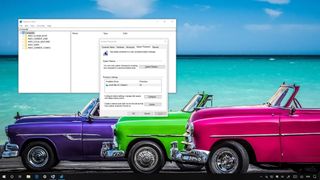
The Registry is perhaps the most critical database in Windows 10, housing all the system settings that your PC and apps to run correctly.
Usually, it's never recommended to make changes to this database, as the smallest mistake can cause stability and boot problems. However, if you really need to modify the Registry to customize the experience, it's a good idea to make a backup of the entire database, in case something goes wrong and you need to revert the changes.
Although there are several methods (including third-party tools) to backup this database, you can use System Restore to quickly backup and restore the entire Registry.
In this Windows 10 guide, we'll walk you through the steps to successfully backup and restore the entire Registry on your device.
How to backup the Registry using System Restore
The easiest way to create a backup of the Windows 10 Registry is using System Restore with these steps:
- Open Start.
- Search for Create a restore point, and click the top result to open the experience.
- Under "Protection Settings," select the System drive.
- Click the Configure button.
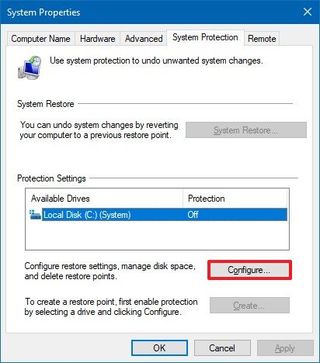
- Select the Turn on system protection option.

- Click the Apply button.
- Click the OK button.
- Click the Create button.

- Type a descriptive name for the backup. For example, Registry Backup 11-16-18.
- Click the Create button.
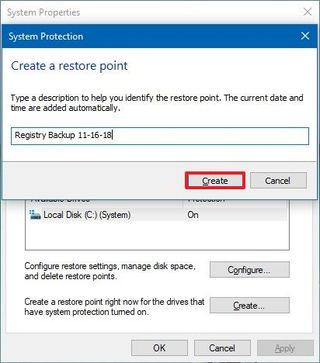
- Click the Close button.
- Click the OK button.
After completing the steps, you'll have a copy of the entire Registry, which you can use at any time to revert settings or repair your system if you're having problems booting up.
While System Restore is a tool designed to give users an option to go back in time to a previous working state, it also creates a backup of the entire Registry, which you can then use to easily restore your system settings.
Get the Windows Central Newsletter
All the latest news, reviews, and guides for Windows and Xbox diehards.
How to restore the Registry using System Restore
If you run into issues, you can restore the Registry from the desktop and the Advanced Startup environment when your device won't boot.
Restoring Registry in desktop
To restore a full backup of the Registry, you can also use the System Restore utility within the Windows 10 desktop with these steps:
- Open Start.
- Search for Create a restore point, and click the top result to open the experience.
- Click the System Restore button.

- Click the Next button.
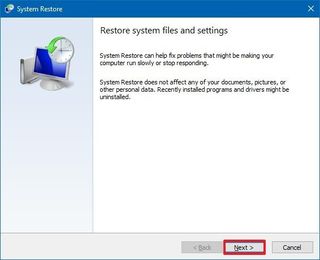
- Select the restore point, which includes the backup of the Registry.
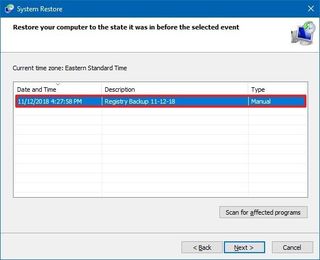
- Click the Next button.
- Click the Finish button.
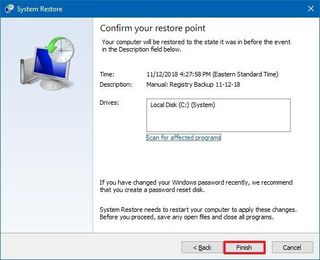
Once you've completed the steps, your computer will need to reboot to complete restoring the previous version of the Registry without affecting your files.
Restoring Registry in recovery
If you're not able to boot into Windows 10, you'll need to access the Advanced Startup environment to use System Restore to recover the Registry, which you can do in at least two different ways.
Accessing recovery without bootable media
To access the Advanced Startup environment without a bootable media, use these steps:
- Turn on your PC.
- As soon as the Windows logo appears on your screen, press the power button. (This will immediately interrupt the boot process.)
- Repeat steps 1 and 2 two more times. After the third interruption, Windows will open into the Advanced Startup environment.
- Click the Troubleshoot option.
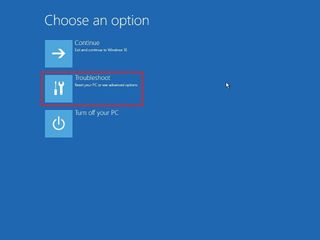
- Click the System Restore option.

- Select the target OS, in this case, "Windows 10."

- Click the Next button.
- Select the restore point with the Registry backup that you created.Quick Tip: If it's been some time since you created the restore point, and the system has a newer backup, it's best to select the latest restore point.

- Click the Next button.
- Click the Finish button.

After you completing the steps, the entire Registry will be restored from backup, and you should now be able to start Windows 10 normally.
Accessing recovery with bootable media
To access the Advanced Startup settings using a bootable media, connect the USB drive with the Windows 10 installation files to your device, power on your device, press any key to continue, and then use these steps:
Important: Before proceeding, make sure your computer is configured to boot from a removable media. Typically, this requires hitting the one of the keyboard's function keys (F1, F2, F3, F10, or F12), ESC, or the Delete key during boot to access the BIOS and change the boot order. However, the instructions will vary depending on your computer manufacturer. Always check your manufacturer's support website for more specific details.
- Click the Next button.

- Click the Repair your computer option in the bottom-left corner.
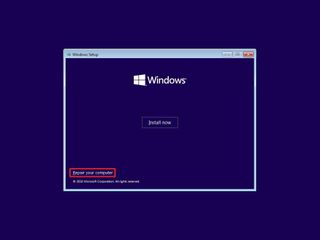
- Click the Troubleshoot option.

- Click the System Restore option.

- Select the target OS, in this case, "Windows 10."

- Click the Next button.
- Select the restore point with the Registry backup that you created.

- Click the Next button.
- Click the Finish button.

Once you've completed the steps, the Registry will restore with all the previous settings allowing your device to boot normally.
Wrapping things up
As a result of enabling the system protection feature, in addition to creating backups of the Registry manually, Windows 10 will now be able to create restore points automatically during certain events (such as during system updates and app installs), which you can also use to undo changes on your computer.
Although you can also use the Registry Editor Export option from the "File" menu to create a full backup, we're not listing this option in this guide, because it's not an option intended to backup and restore the entire Registry.
Using this option, you can create a backup of the entire database, but you're likely to run into issues (such as "error accessing the Registry" or "cannot import. Not all data was successfully written to the Registry") trying to restore the keys using the Registry Editor or Command Prompt.
The export and import options are intended to backup and restore one or multiple Registry keys only.
More Windows 10 resources
For more helpful articles, coverage, and answers to common questions about Windows 10, visit the following resources:
- Windows 10 on Windows Central – All you need to know
- Windows 10 help, tips, and tricks
- Windows 10 forums on Windows Central
Mauro Huculak is technical writer for WindowsCentral.com. His primary focus is to write comprehensive how-tos to help users get the most out of Windows 10 and its many related technologies. He has an IT background with professional certifications from Microsoft, Cisco, and CompTIA, and he's a recognized member of the Microsoft MVP community.

